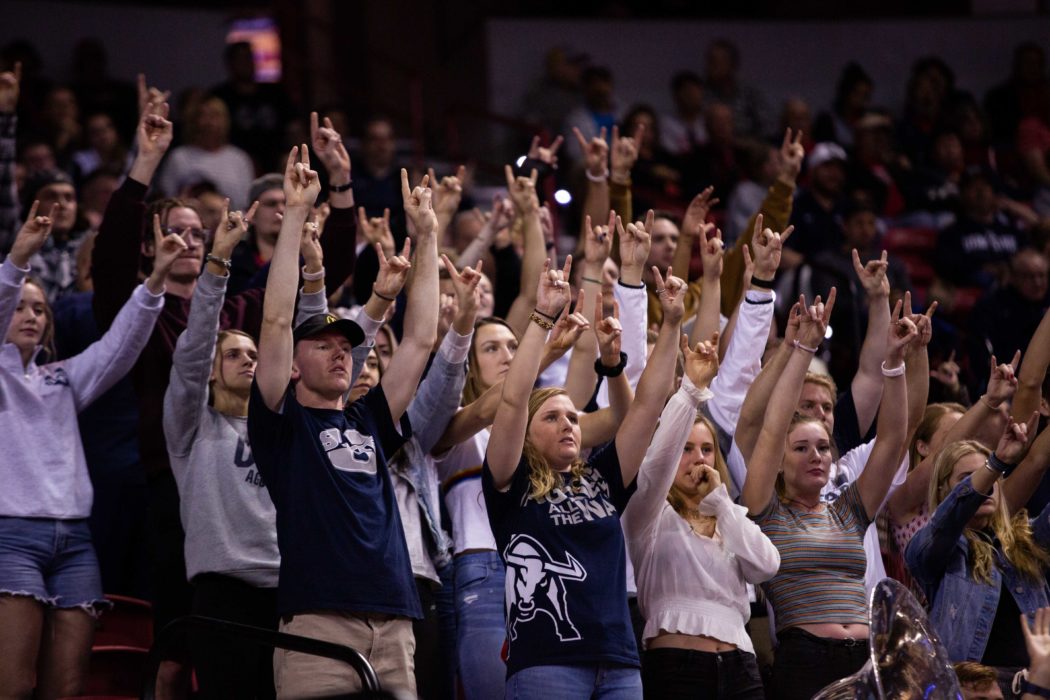Ranking Utah State basketball’s 7 incoming athletes
Utah State’s incoming recruiting class of 2019 is arguably its best ever, a remarkable statement to be made considering the Aggies just finished a season on par with the best of the Stew Morrill era.
According to 247Sports.com, USU is bringing in the best crop of players in the entire Mountain West and has the 62nd best class nationwide. Since joining the MW in 2013, the average rank of Utah State’s recruiting efforts (according to the same site) has been sixth in the conference and 123rd in the NCAA.
Naturally, there is an inclination to rank these players even before they have played a singular minute of Aggie basketball. That is today’s task but with one minor catch. I’m including Roche Grootfaam on the list even though he was on last year’s team because he’ll play his first minutes this season. And I’m not ranking Marco Anthony because he won’t play until 2020. So basically Grootfaam swaps in for Anthony in the pool of players.
So let’s get started.
7. Trevin Dorius
Coming in as the last player to join the roster, and in the second walk-on spot no less, it’s hard to see Dorius anywhere else but at the end of this list and probably the end of the bench.
Dorius wasn’t the most dominant player in high school. A one year starter his senior year, he scored just 9.3 points per game with 7.9 rebounds along with it. Some of that is explained by his lack of minutes (18.8 per outing) which actually raises another red flag (why didn’t he play?). But when you account for his underwhelming amount of playing time, you find Dorius put up a respectable 14.8 points, 12.6 rebounds and 5.3 blocks per 30 minutes.
Since the redshirt freshman is re-joining the team after serving an LDS mission, he will probably need to spend a fair amount of time working himself back into basketball playing shape. Until then, his impact will likely be minimal.
6. Carson Bischoff

Photo via Treasure Valley Community College
The stats Bischoff put up as a sophomore at Treasure Valley Community College —19.7 points, 6.6 rebounds and 2.6 assists — are pretty impressive. Even more eye-popping was his shooting, featuring a 39.1 percent 3-point clip while attempting just over nine (yes, nine) triples per game. Bischoff can rise and fire in basically every scenario.
Shooting alone has put Bischoff on the Utah State roster as a walk-on. But unfortunately, it’s probably the only thing he can contribute to the team. His rebounding and passing numbers likely won’t translate well to DI and there isn’t much else to his game other than those things. He’s not a dynamic athlete or stalwart defender, so shooting will be all that keeps Bischoff on the roster or on the court should that opportunity arise. Think of him as a shorter Brock Miller.
Even though Bischoff is pretty low on the list of newcomers in terms of talent and potential, he could find his way into the rotation almost by default. Utah State returns just three guards: Abel Porter, Sam Merrill and Diogo Brito. Head coach Craig Smith isn’t unwilling to have a backcourt rotation consisting of just those three (it’s what he did for half the season last year), but running his top three guards ragged for 30-plus games likely won’t appeal to Smith. To that end, Bischoff could see a small chunk of minutes in relief of the top three guards, especially in non-conference play. And who knows, maybe he’ll follow in Porter’s footsteps and defy his walk-on status to become a valuable rotation player.
5. Jakub “Kuba” Karwowski
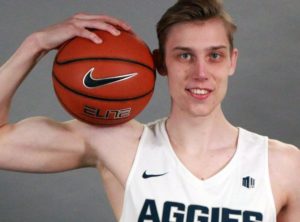
Photo via USU Athletics
The two main things going in favor of “Kuba” Karwowski are that he’s 7-foot-2 and moves better than just about any 7-foot-2 I’ve ever seen. In fact, his fluid movements are on-par with some college players 3-4 inches shorter than him. It’s pretty scary the amount of coordination the Polish center has with his length.
That superb coordination, for better or worse, accounts for basically everything in Karwowski’s wheelhouse in terms of on-court ability. He dunks everything, blocks shots about the same rate and rebounds well. He can’t shoot, pass, dribble or perform more than basic post moves with regularity (he has pulled off a couple of mean post spins, though,). Plus he’s a toothpick who I’d be very surprised if he actually weighed the 230 pounds Utah State’s roster lists him at.
Karwowski needs to eat a few extra sandwiches and hit the gym for practice on the finer points of basketball, but I think he’s the second-best center on the roster at present so don’t be too surprised if Kuba gets a decent amount of court appearances this year to spell Queta. But unlike last year, the Aggies won’t be missing rim protections with Queta on the bench.
4. Liam McChesney
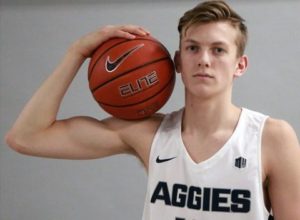
Photo via USU Athletics
You might be surprised to see just how low McChesney is on this list. But while a lot of people think very highly of this kid, myself being included in that group, there are a few things that worry me on film.
Firstly, it’s really hard to gauge just how good someone can be when he’s playing 2A-level basketball in rural Canada. The next closest players in terms of height are usually 6-foot-3, give or take an inch. McChesney is a solid 6-foot-9 and was often more athletic than his 6-foot-3 counterparts. But given that difference, he didn’t appear to dominate his competition on film and he didn’t seem to impact every play the way you’d think a future DI player would at that level.
Too often, McChesney looked passive while going for rebounds, passive looking for baskets or lackadaisical defending off-ball. When locked in, he was the best player on the court, no question. He just wasn’t always locked in.
All that being said, McChesney has the undoubted potential to be the best player on the team. There’s a rare combination of athleticism and length packed into a guy who on paper should be a power forward or center but has the capability to play as though he belongs in the backcourt.
The key in McChesney’s case will just be hard work and spending time adapting to Craig Smith’s system, which will benefit him tremendously. Right now, I just don’t see him hitting the ground running in year one.
3. Roche Grootfaam
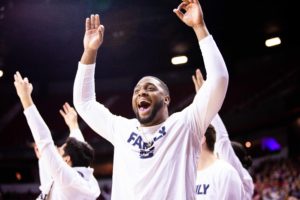
Photo by Megan Nielsen
Right now, Grootfaam is probably the most forgotten name on Utah State’s roster right now and I think that’s a mistake. He’s already got one year of experience with the team and Craig Smith, plus he’s also a pretty good player to boot. He’ll be right in the mix to fill Utah State’s lone open starting spot.
Grootfaam is a powerful athlete. Not explosive, dynamic or quick. Powerful. Watch him play and you’ll see a man who loves to battle in the paint for points or rebounds. And he’s not a below-the-basket type player, unable to battle in vertical space. Grootfaam can get up without needing a runway. The only concern on this end is that he is coming back from knee surgery that ended his 2018-19 campaign before it had a chance to begin.
Setting aside his athleticism, Grootfaam possesses easily the best post game on the team. He has a wide arsenal of moves, counters to those moves and a touch on his shots that would make Kareem Abdul-Jabbar nod in approval. He doesn’t have an outside shot — he attempted one 3-pointer his last active year and missed it — but that won’t necessarily be a barrier for him in my mind.
2. Alphonso Anderson

Photo via Twitter (@Fonzo_10)
Mountain West Wire’s Eli Boettger pegged Anderson as the top newcomer for the Aggies and he may end up being right. The one main starting spot open, power forward, is one where Anderson could easily slide in and fill the void of longtime stalwart Quinn Taylor. Anderson is actually quite similar to Taylor in some ways. In terms of length, one would think they are more suited to be small forwards, but their respective build, weight and play style show that the two are bigs.
Anderson had an impressive amount of statistical success at North Idaho College alongside former Aggie commit RayQuan Evans. Anderson led the team in rebounding average (8.3 per outing) and was third on the team in points per game (15.6) despite scant minutes. Anderson played just over 20 minutes per game, but if you go by a per 30-minute rate, his averages jump to 20.1 points, 10.7 rebounds and 1.3 assists. Toss into all this the fact that Anderson shot a solid 35.7 percent from 3-point land and 48.7 percent overall and Anderson looks like a fountain of efficiency waiting to be tapped.
1. Sean Bairstow
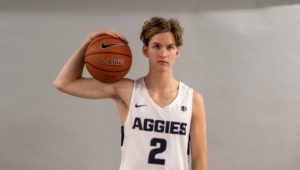
Photo via USU Athletics
You could make an argument for three or four different incoming recruits to be at the top of this list, but Bairstow takes the cake for a few different reasons. Standing 6-foot-8 with an NBA-caliber wingspan (reports are in the 6-foot-11 to 7-foot range) is only part of that. Bairstow combines that length many college post players would envy with the talents of a Division I guard. He has solid handles, a lightning-quick first step and the ability to finish in the paint, either at the rim with a thunderous dunk or a combination of runners and floaters.
In Bairstow’s most recent action playing for the South West Metro Pirates in the QBL in Australia, he made 57 percent of his shots inside the arc. Most of those came within 10 feet using a respectable variety of shots to finish over or around the trees. Shots outside the arc have, unfortunately, a much different story. Bairstow made just three triples in 11 games on 20 attempts.
Another feather in the cap of Bairstow is his experience playing with older, bigger players. The QBL is league with men, not boys. And Bairstow, though basically a boy himself, had to go toe-to-toe with these men and he proved up to the task. In 20 games through two seasons in the QBL, he’s scored 12.2 points per game while reeling in around three rebounds and an assist on the side.
Bairstow is probably the only player I could see stealing away one of the starting slots from an already established member of the opening five. It’s fairly unlikely, but any overachieving on the count of Bairstow would make it hard to not feature him in the rotation with his scoring and great defensive potential.

